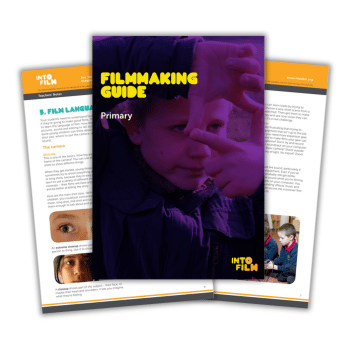19-page PDF
KS1, KS2
Years 1-6
Teaching filmmaking and making your own films at school doesn’t have to be complicated and expensive. You’ve probably already got enough basic gear in your school to get started.
This download comprises a 19-page teacher guide containing activity ideas and practical advice on teaching filmmaking and how to use film activities to teach other subjects.
Teaching filmmaking
Here are some ways to make sure your students get good results, and to make the process manageable and enjoyable.
Keep it short
The number one rule for good filmmaking in school: start short and simple before you try making longer films. Making long or complicated films is a sure way to get learners fed up, bogged down or bored.
The first films they make while they are learning shouldn’t be more than half a minute long. (You’d be surprised how much work it takes to make a really good 20-second film.) They can go on to make longer films once they’ve learnt the basics.
Build skills
Get started with simple activities so your students can discover things like:
- what the different shots are for, and how to use them
- how to work together in filmmaking teams
- how to shoot good video, and how to tell if it’s good
Be clear about the film
Your students will find things a lot easier if they know exactly what kind of film they’re going to make, what it’s for and who’s likely to watch it.
Cut the choice
It might seem odd, but one of the best ways to bring out your students’ creativity in filmmaking is to stop them doing things.
Set really tight limits and they’ll really have to think hard. Tell them the film has to be twenty seconds long, they can only use five shots, or they’ve got to use two closeups, a long shot, a mid shot and a low angle shot.
Let them copy
Young filmmakers can learn loads by trying to copy ‘real’ films. Choose a very short scene from a film the club has watched. Then get them to make a shot-by-shot copy and see how close they can get to the original. It’s a real challenge.
Work with your gear
There’s nothing more frustrating than trying to make a film with equipment that isn’t up to the job. But it doesn’t mean you need more expensive gear, it just means you need to make films your gear can cope with.
No microphone? Don’t try and record live sound, make the soundtrack on your computer or tablet afterwards. Basic camera? Shoot outside or in rooms with plenty of light. No tripod? Zoom out and get in close.
Separate the sound
It’s hard to record good live sound, particularly if you’ve only got basic equipment. Even if you’ve got better gear, you’ll probably still get better results by forgetting the sound while you’re filming and making a soundtrack on your computer.
You can include natural-sounding effects, music and voiceovers, or you could record the voiceover first and edit the pictures to fit.
Into Film’s downloadable resources are designed to be used in conjunction with selected film titles, which are available free for clubs.














